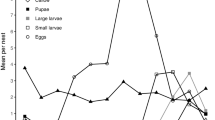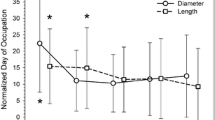Abstract
Body size has often been related to reproductive success in bees and wasps. The objective of this 3-year study was to analyze the relationship between nesting female body size, provisioning rate and longevity and their effect on several traits related to parental investment and reproductive success in the solitary bee Osmia cornuta. Body size was not correlated to longevity, and it was only correlated to provisioning rate in the third year (with poor weather conditions during nesting). Variation in fecundity, offspring size and offspring mortality was not well explained by nesting female body size in any of the 3 years. However, in the third year, small females biased their investment toward males, the sex requiring smaller pollen–nectar provisions. Large females were more successful usurpers of other females' nests, but fecundity of usurpers was no higher than fecundity of nonusurpers. Large females were more likely to establish at the release site, probably in relation to size-dependent vigor at emergence. A review of the literature on parental investment in solitary aculeate Hymenoptera showed a stronger relationship between body size and reproductive success in wasps than in bees. In O. cornuta, fecundity was strongly related to longevity and provisioning rate in all 3 years. Offspring size was associated with provisioning rate in 1 year, when females with higher provisioning rates tended to produce larger sons and daughters. Both longevity and provisioning rate appeared to be strongly conditioned by stochastic events.
Similar content being viewed by others
References
Alcock J (1979) The relation between female body size and provisioning behavior in the bee Centris pallida Fox (Hymenoptera: Anthophoridae). J Kans Entomol Soc 52:623–632
Alcock J (1982) Nest usurpation and sequential nest occupation in the digger wasp Crabro monticola (Hymenoptera: Sphecidae). Can J Zool 60:921–925
Alcock J (1990) Body size and territorial behavior in the bee Protoxaea gloriosa (Fox) (Hymenoptera: Oxaeidae). Pan-Pac Entomol 66:157–161
Alcock J, Eickwort GC, Eickwort KR (1977) The reproductive behavior of Anthidium maculosum (Hymenoptera: Megachilidae) and the evolutionary significance of multiple copulations by females. Behav Ecol Sociobiol 2:385–396
Arakawa R, Miura M, Fujita M (2004) Effects of host species on the body size, fecundity, and longevity of Trissolcus mitsukurii (Hymenoptera: Scelionidae), a solitary egg parasitoid of stink bugs. Appl Entomol Zool 39:177–181
Barthell JF, Thorp RW (1995) Nest usurpation among females of an introduced leaf-cutter bee, Megachile apicalis. Southwest Entomol 20:117–124
Bosch J (1994a) The nesting behaviour of the mason bee Osmia cornuta (Latr) with special reference to its pollinating potential (Hymenoptera, Megachilidae). Apidologie 25:84–93
Bosch J (1994b) Improvement of field management of Osmia cornuta (Latreille) (Hymenoptera, Megachilidae). Apidologie 25:71–83
Bosch J, Kemp WP (2004) Effect of pre-wintering and wintering temperature regimes on weight loss, survival, and emergence time in the mason bee Osmia cornuta (Hymenoptera: Megachilidae). Apidologie 35:469–479
Bosch J, Vicens N (2002) Body size as an estimator of production costs in a solitary bee. Ecol Entomol 27:129–137
Bosch J, Vicens N (2005) Sex allocation in a solitary bee: do females behave in agreement with Fisher's theory? Behav Ecol Sociobiol 59:124–132
Brockmann HJ, Grafen A (1989) Mate conflict and male behaviour in a solitary wasp, Trypoxylon (Trypargilum) politum (Hymenoptera: Sphecidae). Anim Behav 37:232–255
Charnov EL (1982) The theory of sex allocation. Princeton University Press, Princeton
Cowan DP (1981) Parental investment in two solitary wasps Ancistrocerus adiabatus and Euodynerus foraminatus (Eumenidae: Hymenoptera). Behav Ecol Sociobiol 9:95–102
Doyon J, Boivin G (2005) The effect of development time on the fitness of female Trichogramma evanescens. J Insect Sci 5:4 (http://www.insectscience.org/5,4)
Eliopoulos PA, Stathas GJ, Bouras SL (2005) Effects and interactions of temperature, host deprivation and adult feeding on the longevity of the parasitoid Venturia canescens (Hymenoptera: Ichneumonidae). Eur J Entomol 102:181–187
Frank SA, Swingland IR (1988) Sex ratio under conditional sex expression. J Theor Biol 135:415–418
Freeman BE (1981) Parental investment, maternal size and population dynamics of a solitary wasp. Am Nat 117:357–362
Frohlich DR, Tepedino VJ (1986) Sex ratio, parental investment, and interparental variability in nesting success in a solitary bee. Evolution 40:142–151
Gerber HS, Klostermeyer EC (1970) Sex control by bees: a voluntary act of sex fertilization during oviposition. Science 167:82–84
Goulson D, Peat J, Stout JC, Tucker J, Darvill B, Derwent LC, Hughes WOH (2002) Can alloethism in workers of the bumblebee Bombus terrestris be explained in terms of foraging efficiency? Anim Behav 64:123–130
Hastings J (1986) Provisioning by female western cicada killer wasps, Sphecius grandis (Hymenoptera: Sphecidae): influence of body size and emergence time on individual provisioning success. J Kans Entomol Soc 59:262–268
Johnson MD (1988) The relationship of provision weight to adult weight and sex ratio in the solitary bee, Ceratina calcarata. Ecol Entomol 13:165–170
Johnson MD (1990) Female size and fecundity in the small carpenter bee, Ceratina calcarata (Robertson) (Hymenoptera: Anthophoridae). J Kans Entomol Soc 63:414–419
Kim J-Y (1997) Female size and fitness in the leaf-cutter bee Megachile apicalis. Ecol Entomol 22:275–282
Kim J-Y, Thorp RW (2001) Maternal investment and size-number trade-off in a bee, Megachile apicalis, in seasonal environments. Oecologia 126:451–456
Klostermeyer EC, Mech SJ, Rasmussen WB (1973) Sex and weight of Megachile rotundata (Hymenoptera: Megachilidae) progeny associated with provision weights. J Kans Entomol Soc 46:536–548
Larsson FK, Tengö J (1989a) The effects of temperature and body size on the mating pattern of a gregariously nesting bee, Colletes cunicularius (Hymenoptera: Colletidae). Ecol Entomol 14:279–286
Larsson FK, Tengö J (1989b) It is not always good to be large; some female fitness components in a temperate digger wasp, Bembix rostrata (Hymenoptera: Sphecidae). J Kans Entomol Soc 62:490–495
Maeta Y, Sugiura N, Goubara M (1992) Patterns of offspring production and sex allocation in the small carpenter bee, Ceratina flavipes Smith (Hymenoptera, Xylocopinae). Jpn J Entomol 60:175–190
Molumby A (1997) Why make daughters larger? Maternal sex-allocation and sex-dependent selection for body size in a mass-provisioning wasp, Trypoxylon politum. Behav Ecol 8:279–287
Morse DH (1978) Size-related foraging differences of bumble bee workers. Ecol Entomol 3:189–192
O'Neill KM (1983) The significance of body size in territorial interactions of male beewolves (Hymenoptera: Sphecidae). Can J Zool 63:2187–2193
O'Neill KM (1985) Egg size, prey size, and sexual dimorphism in digger wasps (Hymenoptera: Sphecidae, Philanthus). Anim Behav 31:404–411
O'Neill KM, Evans HE, O'Neill RP (1989) Phenotypic correlates of mating success in the sand wasp Bembecinus quinquespinosus (Hymenoptera: Sphecidae). Can J Zool 67:2557–2568
Phillips JK, Klostermeyer EC (1978) Nesting behavior of Osmia lignaria propinqua Cresson (Hymenoptera: Megachilidae). J Kans Entomol Soc 51:91–108
Pyke GH (1978) Optimal body size in bumblebees. Oecologia 34:255–266
Rice WR (1989) Analyzing tables of statistical tests. Evolution 43:223–225
Rosenheim JA, Nonacs P, Mangel M (1996) Sex ratios and multifaceted parental investment. Am Nat 148:501–535
Sagarra LA,Vincent C, Stewart RK (2001) Body size as an indicator of parasitoid quality in male and female Anagyrus kamali (Hymenoptera: Encyrtidae). Bull Entomol Res 91:363–368
Severinghaus LL, Kurtak BH, Eickwort GC (1981) The reproductive behavior of Anthidium manicatum (Hymenoptera: Megachilidae) and the significance of size for territorial males. Behav Ecol Sociobiol 9:51–58
Smith CC, Fretwell SD (1974) The optimal balance between size and number of offspring. Am Nat 108:499–506
Stone GN (1994) Activity patterns of the solitary bee Anthophora plumipes in relation to temperature, nectar supplies and body size. Ecol Entomol 19:177–189
Stout JC (2000) Does size matter? Bumble bee behaviour and the pollination of Cytisus scoparius L. (Fabaceae). Apidologie 31:129–139
Strohm E (2000) Factors affecting body size and fat content in a digger wasp. Oecologia 123:184–191
Strohm E, Linsenmair KE (1997) Female size affects provisioning and sex allocation in a digger wasp. Anim Behav 54:23–34
Strohm E, Lechner K (2000) Male size does not affect territorial behaviour and life history traits in a sphecid wasp. Anim Behav 59:183–191
Strohm E, Linsenmair KE (2000) Allocation of parental investment among individual offspring in the European beewolf Philantus triangulum F. (Hymenoptera: Sphecidae). Biol J Linn Soc 69:173–192
Sugiura N (1991) Male territoriality and mating tactics in the wool-carder bee, Anthidium septemspinosum Lepeletier (Hymenoptera: Megachilidae). J Ethol 9:95–103
Sugiura N (1994) Parental investment and offspring sex ratio in a solitary bee, Anthidium septemspinosum Lepeletier (Hymenoptera, Megachilidae). J Ethol 12:131–139
Sugiura N, Maeta Y (1989) Parental investment and offspring sex ratio in a solitary mason bee, Osmia cornifrons (Radoszkowski) (Hymenoptera, Megachilidae). Jpn J Entomol 57:861–875
Tepedino VJ, Torchio PF (1982) Phenotypic variability in the nesting success among Osmia lignaria propinqua females in a glasshouse environment (Hymenoptera: Megachilidae). Ecol Entomol 7:453–462
Tepedino VJ, Torchio PF (1989) The influence of nest-hole selection on sex ratio and progeny size in Osmia lignaria propinqua (Hymenoptera: Megachilidae). Ann Entomol Soc Am 82:355–360
Tepedino VJ, Torchio PF (1994) Founding and usurping: equally efficient paths to nesting success in Osmia lignaria propinqua (Hymenoptera: Megachilidae). Ann Entomol Soc Am 87:946–953
Trivers RL, Willard DE (1973) Natural selection of parental ability to vary the sex ratio of offspring. Science 179:90–92
van den Assem J, van Iersel JJA, Los-den-Hartogh RL (1989) Is being large more important for female than for male parasitic wasps? Behaviour 108:160–195
Vicens N, Bosch J (2000) Weather-dependent pollinator activity in an apple orchard, with special reference to Osmia cornuta and Apis mellifera (Hymenoptera: Megachilidae and Apidae). Environ Entomol 29:413–420
Willmer PG (1985a) Size effects on the hygrothermal balance and foraging patterns of a sphecid wasp, Cerceris arenaria. Ecol Entomol 10:469–479
Willmer PG (1985b) Thermal ecology, size effects, and the origins of communal behaviour in Cerceris wasps. Behav Ecol Sociobiol 17:151–160
Acknowledgements
We are indebted to the staff at Mas Bové for their support throughout the study and to J. Calzadilla, M.A. Escolano, M. López, and J. Losarcos for generously sharing many hours of field observations and nest dissections. The manuscript benefited from the comments of J. Retana (CREAF-Universitat Autònoma de Barcelona) and an anonymous reviewer. This study complies with Spanish laws and was supported by a FPI scholarship from the Spanish MEC to J.B., a Dirección General de Investigación Cientifica y Técnica (DGICYT) grant (AGR 91-0988-CO3) and an INIA grant (88-8191).
Author information
Authors and Affiliations
Corresponding author
Additional information
Communicated by R.F.A. Moritz
Rights and permissions
About this article
Cite this article
Bosch, J., Vicens, N. Relationship between body size, provisioning rate, longevity and reproductive success in females of the solitary bee Osmia cornuta . Behav Ecol Sociobiol 60, 26–33 (2006). https://doi.org/10.1007/s00265-005-0134-4
Received:
Revised:
Accepted:
Published:
Issue Date:
DOI: https://doi.org/10.1007/s00265-005-0134-4




